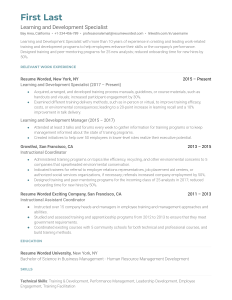Specialized Services For Job Application Documents
When applying for a job, the company may require more information than just your resume and cover letter. These additional materials are called supporting documentation. A company requests these documents to verify information on your application and/or to get a better understanding of who you are as a person. Examples of these documents include educational transcripts, writing homework market login samples, Veterans’ Preference documents, portfolios, certifications and references. Typically, a job announcement will indicate which documents are required for the position.
A specialized resume is one that is tailored to the job announcement or description. By tailoring your resume to the specific requirements of a particular position, you can demonstrate that you have the skills and experience for the job. It is important to read the vacancy announcement and description thoroughly, so you know what type of information is needed for an application.
In some cases, a job applicant will be asked to provide a personal statement, which is more like a letter of introduction. This statement is meant to give a more detailed picture of the candidate’s qualifications, including work history and volunteer experience. This statement is usually requested for professional jobs or positions with a higher level of responsibility.
After reviewing all of the necessary documents, it is time to submit them. Remember to follow all instructions in the job announcement as far as submitting your materials. For example, if an employer only accepts electronic submissions, be sure to email your client’s documents as PDFs. Also, be sure to follow a consistent document naming convention so that the agency can easily identify your client’s documents. Finally, if your client needs accommodations for the interview process, be sure to contact the DPM, SPPC, or HR professional listed on the job vacancy announcement to discuss this in advance.

Do You Offer Specialized Services For Job Application Documents?
It’s also worth noting that specific formatting requests may extend beyond the visual presentation of the document. Accessibility considerations, such as the use of alternative text for images, proper heading structures for screen readers, and other accommodations for individuals with disabilities, should be taken into account. In many cases, these considerations are not only ethical but may also be required by legal regulations.
Additionally, as technology advances, the ways in which documents are created and shared continue to evolve. Online platforms and content management systems often have their own set of formatting options. Users can customize their documents to fit the requirements of these platforms, whether it’s for a blog post, a website, or a collaborative document shared in the cloud.
In conclusion, the ability to request specific formatting for your document is not only permissible but often encouraged. Whether you are working on a personal project, a collaborative effort, or within the confines of established guidelines, taking the time to understand and implement the desired formatting can significantly enhance the overall impact and effectiveness of your document. Clear communication, flexibility, and a willingness to adapt to specific requirements are key elements in ensuring that your document is not only well-written but also visually and structurally appealing.